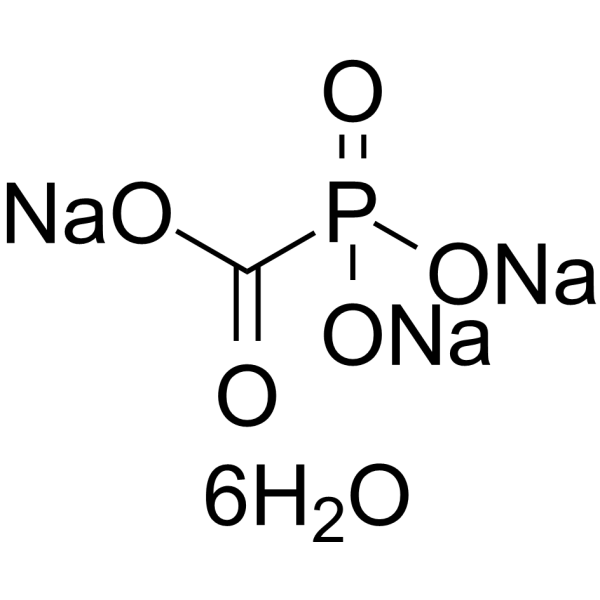
Phosphonoformic acid trisodium salt hexa
CAS No. 34156-56-4
Phosphonoformic acid trisodium salt hexa( foscarnet sodium hexahydrate | Sodium phosphonatoformate hexahydrate )
Catalog No. M28595 CAS No. 34156-56-4
Phosphonoformic acid trisodium salt hexa is an antiviral drug for the treatment of CMV retinitis.
Purity : >98% (HPLC)
 COA
COA
 Datasheet
Datasheet
 HNMR
HNMR
 HPLC
HPLC
 MSDS
MSDS
 Handing Instructions
Handing Instructions
| Size | Price / USD | Stock | Quantity |
| 1G | 26 | Get Quote |


|
Biological Information
-
Product NamePhosphonoformic acid trisodium salt hexa
-
NoteResearch use only, not for human use.
-
Brief DescriptionPhosphonoformic acid trisodium salt hexa is an antiviral drug for the treatment of CMV retinitis.
-
DescriptionPhosphonoformic acid trisodium salt hexa is an antiviral drug for the treatment of CMV retinitis.
-
In VitroFoscarnet sodium (Phosphonoformic acid) inhibit the human cytomegalovirus DNA polymerase (UL54) by mimicking the pyrophosphate leaving group of the nucleotide transfer reaction.Foscarnet sodium (Trisodium phosphonoformate) inhibits Influenza A Victoria (IC50=29 μM), Influenza B HK (IC50=61 μM), and Avian myeloblastosis virus (IC50=5-8 μM), HSV-1, several strains (IC50=0.4-3.5 μM).
-
In Vivo——
-
Synonymsfoscarnet sodium hexahydrate | Sodium phosphonatoformate hexahydrate
-
PathwayOthers
-
TargetOther Targets
-
Recptorα1-adrenoceptor
-
Research Area——
-
Indication——
Chemical Information
-
CAS Number34156-56-4
-
Formula Weight126.01
-
Molecular FormulaCH3O5P
-
Purity>98% (HPLC)
-
Solubility——
-
SMILESO=C(P(O)(O)=O)O
-
Chemical Name——
Shipping & Storage Information
-
Storage(-20℃)
-
ShippingWith Ice Pack
-
Stability≥ 2 years
Reference
1.Roquebert J, et al. Inhibition of the alpha 1 and alpha 2-adrenoceptor-mediated pressor response in pithed rats by raubasine, tetrahydroalstonine and akuammigine. Eur J Pharmacol. 1984 Oct 30;106(1):203-5.
molnova catalog



related products
-
Deoxyvasicinone
Deoxyvasicinone derivatives can be considered as promising lead molecules for the development of more potent inhibitors of NEDD8-activating enzyme.
-
Carzenide
Carzenide is an organic synthesis intermediate, for synthetic drug.
-
Glutaminase C-IN-1
Glutaminase C-IN-1 is a Glutaminase C allosteric inhibitor.



 Cart
Cart
 sales@molnova.com
sales@molnova.com


